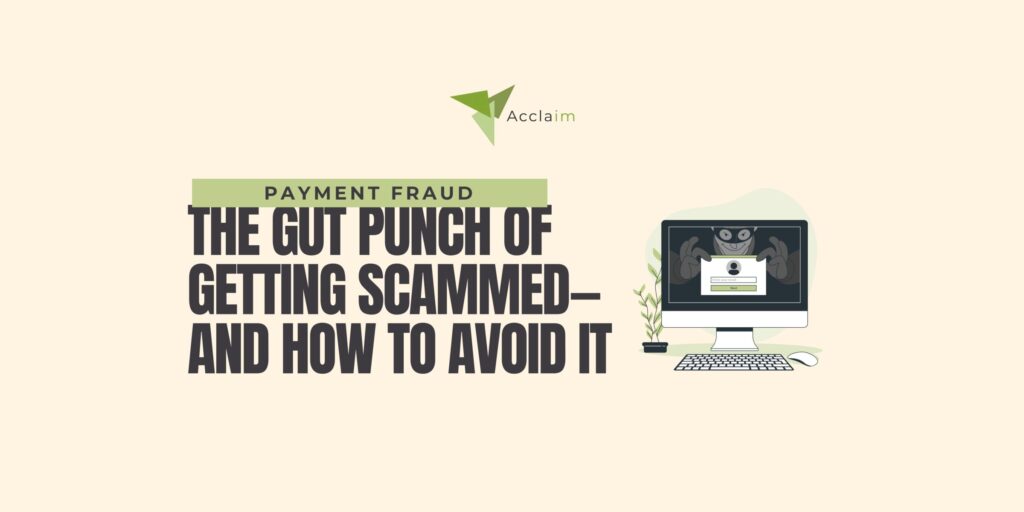
Company News
The Gut Punch of Getting Scammed – And How to Avoid It
Most businesses have had some form of exposure to payment fraud in some way or another. That moment when you feel great because you spotted it before the payment, or the absolute gut-wrenching feeling if it’s after the event.
So what are the common actions we can take to limit our exposure:
-
Strengthen Verification
- Dual-control on payee changes
Always require secondary validation (e.g., phone call to a known number) for any new or amended payee/payment details. Cyber‑criminals frequently spoof internal or supplier emails to request invoice changes . - Invoice screening & matching systems
Implement systems to match invoices automatically against purchase orders and known vendor info; flag discrepancies in routing, banking details, or amounts . - Verify by independent channels
Never trust change notifications sent via email alone—always confirm via a different, trusted channel (e.g., phone line stored on file). Check the details on an invoice back to the original website of the company – do not click on any links within an invoice. - Don’t be afraid to ask your colleagues if they have had any dealings with the supplier and is a genuine service.
-
Common Fraud Types
- Invoice fraud / BEC (Business Email Compromise)
Scammers spoof customers with fake invoices or legal threat messages to prompt urgent payment. Some scams will have mirrored a business’ invoice style with the objective of diverting payment into their hands. - Impersonation & refund scams
Fraudsters may pose as your bank, police, or internal team requesting “safe‑account” transfers or OTP codes, claiming there’s a refund or account security issue. - Advance fee scams (“payment in advance fraud”)
Requests for upfront payments to release goods, supplies or contracts —once paid, victims never receive promised rewards.
-
Secure Technical Controls
- Biometric and multi-factor authentication (MFA)
Enable biometric approval for new payees or high-value transfers. This method adds a strong layer of identity verification . - Device & network hygiene
• Keep anti-virus, anti-spyware, firewalls, and OS/app updates current .
• Avoid using unsecured public Wi‑Fi for sensitive operations—either use private 3G/4G or ask staff to wait until on a secure network. - Consider restricting payment processing and/or authorisation to dedicated computers.
- Protect credentials
Staff should memorize PINs or one-time passcodes and never store them in browsers, share them, or disclose them—banks will never request them over unsolicited channels. - DO NOT LEAVE YOUR CARDREADER DEVICES CONNECTED TO YOUR COMPUTER and secure your security cards.
-
Education & Culture of Vigilance
- Phishing and spoofing training
Train your team to recognize phishing emails, impersonation calls, and spoofed sender addresses; ensure they always follow escalation protocols . - Empower delay & escalation
Encourage employees to take a breath and pause – when faced with unusual payment requests. Even seemingly minor delays or second opinions can prevent fraud . - Regular account reviews
Promote frequent reviews of transaction histories and statements to catch suspicious activity early .
-
Response & Reporting Protocols
- Make sure your procedures surrounding payments have been beta tested before implementation.
- Immediately contact the bank and report the incident. They may not have completed the payment and may be able to help – It’s always worth trying.
- Dedicated fraud reporting channels
Provide internal procedures for suspected incidents, including escalation to the MLRO. - Liaise with authorities promptly, report confirmed or suspected fraud to:
- Economic Crime Unit of the Isle of Man Police.
- Action Fraud in the UK, if cross-border elements are involved
- Isle of Man Financial Intelligence Unit
-
Proactive Process Safeguards
- Implement transaction thresholds
Set automatic alerts or hold-and-review triggers for payments over predetermined limits or to new beneficiaries. - Run regular audits and reconciliation
Perform frequent reconciliations between payments, invoices, and bank statements. Audit vendor bank details periodically.
✅ Manager-Level Action Plan
| Area | Key Activity |
| Policy & Controls | Enforce dual-control protocols; validate changes by alternate channel |
| Technology | Enable biometric MFA; enforce updates and use secure networks |
| Training & Awareness | Regular phishing and fraud scenario training; stress escalation |
| Incident Response | Establish clear reporting lines; liaise immediately with bank & IOMFIU and ECU/Action Fraud |
| Oversight & Audit | Regular reconciliation; audit vendor details; trigger alerts for anomalies |
| Continuous Improvement | Review incidents and update policies regularly |
Final Takeaway
Preventing payment fraud demands a blend of robust internal controls, awareness training, technological safeguards, and rapid response procedures. By embedding these into your team’s daily operations—alongside clear escalation and reporting pathways—you significantly reduce the risk of costly fraud incidents and maintain trust with your clients.
Share This Article





